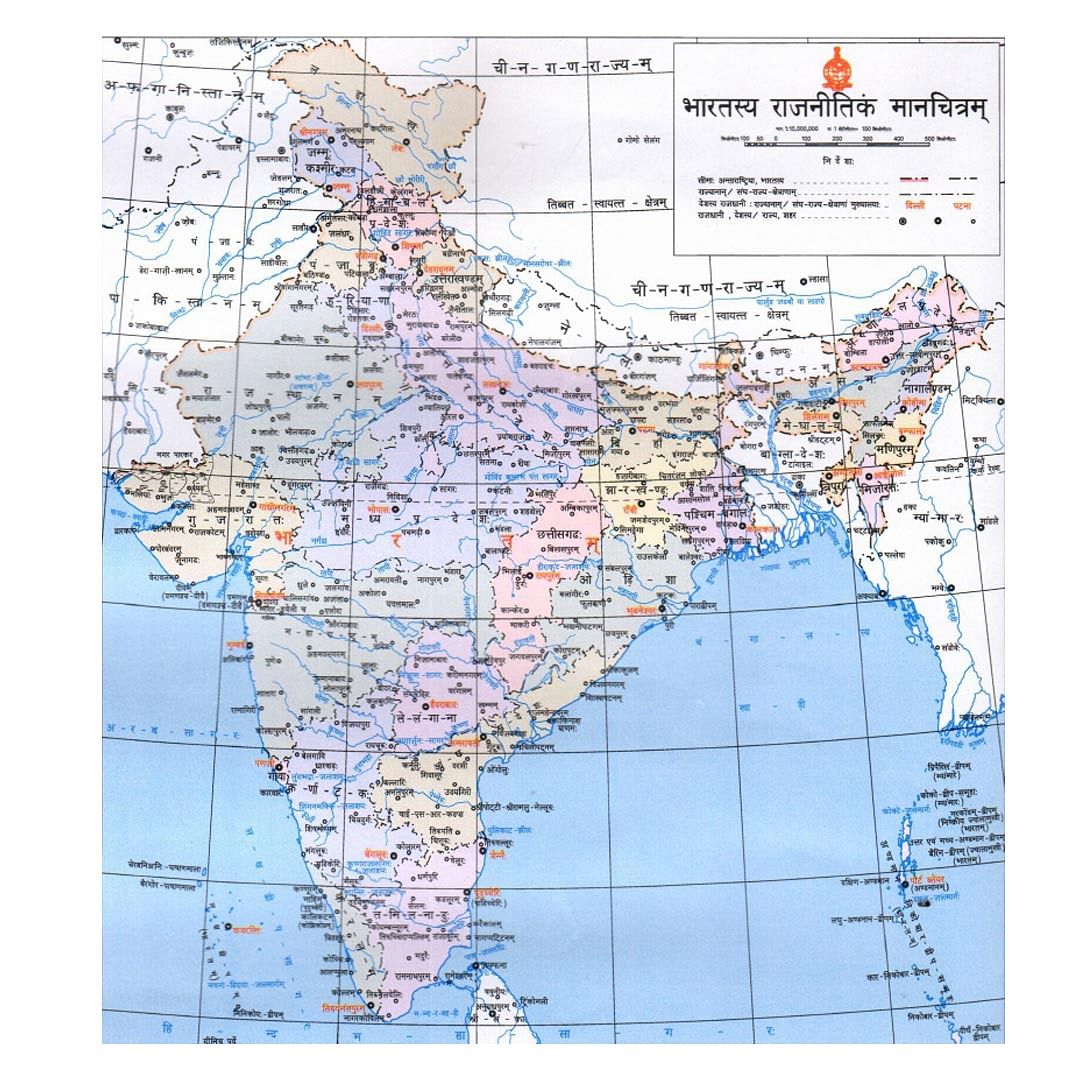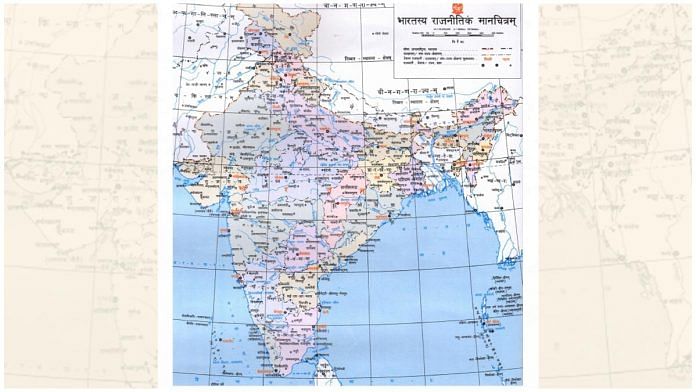New Delhi: For the first time in 18 years, the Survey of India has released an updated political map of India in the Sanskrit language, as part of the National Science Day celebrations.
The last time such a map was released was back in 2002, when Atal Bihari Vajpayee’s NDA government was in power.
The Sanskrit and the Hindi maps were unveiled Friday at Vigyan Bhavan by Harsh Vardhan, Union Minister of Science & Technology.
Also read: India is using hundreds of drones to map the country in incredible detail
How the names change
Most of the names of cities and states are the same as in Hindi, with additional Sanskrit suffixes of ‘am’ and ‘ah’. Rajasthan, for example, is shown as ‘Rajasthanam’, Punjab is called ‘Punjabah’, Kerala is ‘Keralam’, while Karnataka is ‘Karnatakah’.

Even the English-suffixed Nagaland has been Sanskritised by adding just an ‘am’ — the map calls it ‘Nagalandam’.
The new union territories of Ladakh and Jammu & Kashmir are given as ‘Laddakhah’ and ‘Jammuh Kashmirah’.
City names follow a similar pattern — Mumbai and Kolkata remain as is, ‘Dillih’ and ‘Chennaih’ feature minor Sanskritisation, while Gangtok becomes ‘Gangatokah’.
The map also marks water bodies like rivers and reservoirs — the river names, being mostly Sanskrit-derived, remain pretty much the same, while the reservoirs are marked as ‘Govind Sagarah’, ‘Nagarjunah Sagarah’,
The map even Sanskritises neighbouring countries and their cities — ‘Afghanistanam’, ‘Pakistanam’, ‘Islamabadah’ and ‘Peshawaram’. China is marked as ‘Cheen-Ganrajyam’ (literally, China republic), while the region of Tibet is called ‘Tibbat-Swayatt-Kshetram’, the equivalent of Tibet Autonomous Region, as China calls it.
However, the map also features some faux pas, such as referring to lakes as ‘jheelah’—such as the ‘Sambhar-jheelah’ in Rajasthan and the ‘Mansarovar-jheelah’ in China. The Sanskrit word for lake is ‘sarovar’ or ‘sar’, while ‘jheel’ is a Hindi word.
Demand for a Sanskrit map
The English map, updated with the new union territories of J&K and Ladakh, was released in November last year.
However, the Sanskrit map has made a comeback after being published intermittently since 1977. The Survey of India, which is part of the Department of Science and Technology, had published Sanskrit maps in 1979, 1983, 1988, 1997 and 2002.
The two UPA governments as well as the first Narendra Modi government did not publish the map, despite the creation of the new state of Telangana out of Andhra Pradesh in 2014.
Surveyor General of India Lt Gen. Girish Kumar (retd) told ThePrint: “We have been publishing (the maps) regularly in English, and sometimes in Hindi. Now I want to regularly bring out these maps in all regional languages, and since Sanskrit is an ancient language, we should definitely support it.”
He added that there is a demand for Sanskrit maps for exhibitions and events, especially in the Hindi belt, while organisations and institutions in Haridwar and parts of Uttar Pradesh also keep asking for such maps.
Pankaj Mishra, deputy director at the Survey of India, pointed out that a lot of administrative changes had taken place since the last Sanskrit map was published in 2002.
“Last November, the English map was unveiled, and it generated a lot of interest. People were then looking for versions in other official languages, for helpdesks and exhibitions,” he said.
“Nowadays, even our printing systems are digital. So, it is not that difficult anymore to produce these maps in any language. We will make physical prints of the maps according to the demand.”
Usually, the Survey of India publishes only state maps in regional languages, according to demand.
Also read: Nepal upset as India’s new map depicts disputed Kalapani as part of Uttarakhand




Whoever wrote the Sanskrit spellings on this Map don’t have even a basic knowledge of Sanskrit.
Sanskrit never use a vowel letter in between or in the end of the word and the same spelling rule is found in all South Indian languages but in this map there are many spellings written by using the vowel in the end Eg. मुंबई should be spelled as मुम्बयी . Actually they have just adopted the Hindi spellings and Sanskritised them.
Another mistake is Nagalandam It should be Nagalandah because landam sounds like Latin.
The suffix should be used because after its the real name of the State but Instead of M , H should be used for Sanskritisation because M is used for the Latinisation of English Words.
Nagalandum ?? seems to quite hilarious. I remember when we first opted for Sanskrit in middle school, our Sanskrit teacher recited “falam, falay falani, Sanskrit na aani, Sanskrit aani to booljani, Sanskrit ki naani marjani ‘ on the way we pronounced some sanskrit words.
Precisely what the economy needs these days !
The word ‘land’ in nagaland is an English word. I think it should be replaced by the sanskrit word. By adding the suffix ‘am’ after ‘land’ does not sanskritise the name. Maybe ‘nagadeshah’ or ‘nagadesham’ would be better.
It is a pity an entire linguistic universe of samskritham has been relegated to sidelines
India will learn samskritham from westerners soon
That day we will hang our heads in shame
Very good identifying the States in India. Alas piss poor feeding them and providing them jobs.